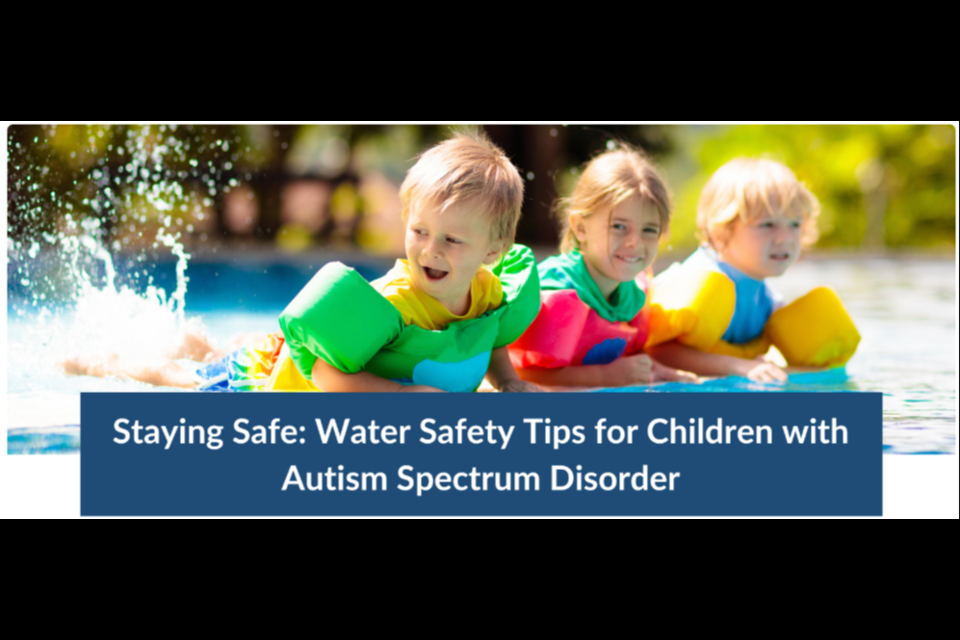Florida Autism Center, aka BlueSprig Pediatrics, wants to ensure all families have access to the proper resources needed to ensure their loved ones live a happy and fulfilling life. According to the CDC, drowning is the leading cause of death in children with autism, and the leading cause of injury-related death among children between 1 and 4 years old.
The Florida Autism Center is commited to empowering families with effective techniques to safeguard children with autism and their loved ones while swimming, and in everyday life, by ensuring they have access to the right swim-safety resources.
In honor of National Water Safety Month, they've collaborated with AquaSafe Swim School to present valuable swimming and water safety advice, suggestions and materials for families everywhere.
Water safety tips
- Always supervise children when they are in and around water.
- When multiple adults are present, it can be easy to assume that someone is always watching. Since drowning is often silent and can happen quickly, always identify who is responsible for watching each child, and have a clear plan for handing off responsibility.
- Prioritize your child's safety and reduce any potential interruptions by preparing everything you require for bath time beforehand, prior to placing your child in the tub.
- Make certain to empty out buckets, containers and small pools (like kiddie pools) when they are not being used, and also ensure that bathtubs are completely drained.
- Learn CPR and water rescue skills. Here is a great resource from the Red Cross.
- For additional tips on safety in the home, click here.
Take water safety precautions
- Depending on the child’s age, emphasize and teach the dangers of water. The goal isn’t to instill fear, but instead to understand and have a healthy respect for water.
- According to an AAP study, about 50% of parents of autistic children 4 years of age state that their child had either attempted or succeeded in wandering. If death occurs secondary to the wandering, it is mostly due to drowning. Be sure to take the appropriate safety measures, for example, child safety locks on doors that lead outside to prevent a child from leaving without supervision.
- Install fences around home pools.
- If you live in a neighborhood with bodies of water, ensure the proper fencing is in place to prevent roaming.
- Look into additional safety devices such as pool alarms, water alarm bracelets and GPS monitoring devices, such as AngelSense, for children prone to wandering.
- Talk to your neighbors and your community to help them understand the importance of these safety precautions.
Start water safety early
- ABA therapy can help build skills necessary for everyday safety. BlueSprig helps children learn safety skills that can benefit them in all aspects of their life such as following instructions, ensuring they are with an adult/walking with an adult, etc.
- Instill in children the necessary skills to swim. Enrolling them in a swim school at a young age acquaints children with water safety while providing supervision. According to the National Library of Medicine, swim lessons can reduce the risk of drowning by 88%.
- It's important to approach swimming as a learning process for children with ASD and ease them into it. One option is to rely on swimming schools like SafeSplash, which employ instructors specifically qualified to address the needs of children with sensory disabilities.
Communication, sensory considerations
- Be sure to review water safety rules together as a family. Children with ASD often respond well to visual cues. Consider using pictures or symbols to help your child understand safety rules – you might consider hanging up the rules in your house.
- Design an environment free of stimulating factors:
- It's best to refrain from having loud background music or allowing a large number of children in the pool as it can become overwhelming and cause fear.
- Maintain a composed demeanor and reduce stress by being well-prepared with safety measures beforehand.
- Water can be overstimulating. Aqua shoes or a swim shirt can help with sensory overload and can help your child feel where their feet and body are when in the water.
- While bright colors may be overstimulating, for water safety, they recommend always putting your child in bright-colored clothing so you can easily identify them in the water.
For more information about ABA therapy and to find resources for your family and your child with ASD, visit the BlueSprig website. To find a AquaSafe swim school near you, visit the AquaSafe website.



